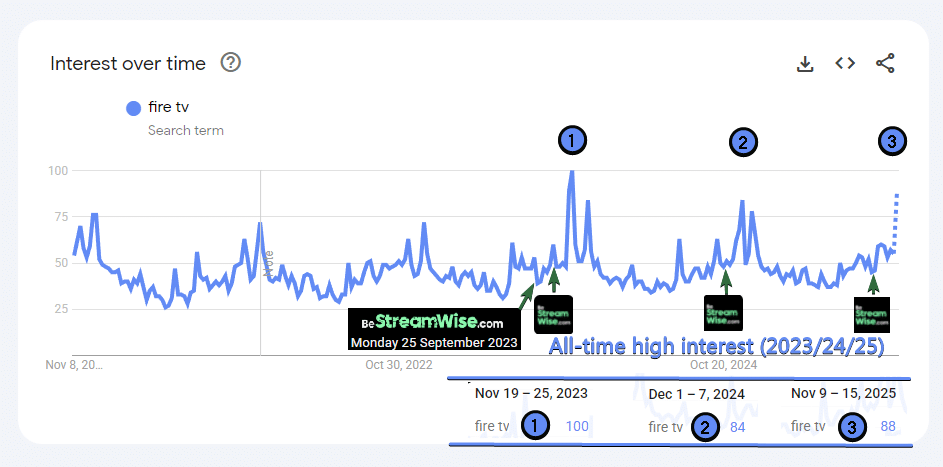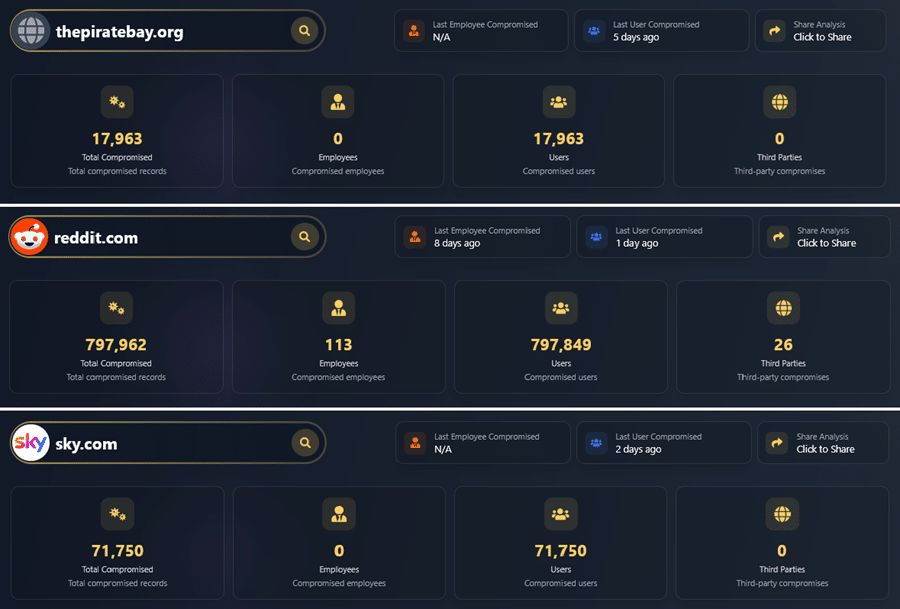It appears that Fire Stick Crackdown Malware Armageddon Month is upon us once again. While there is legitimate news, including Amazon’s updated anti-piracy policy, a steady stream of clickbait makes it difficult to properly value every announcement. Unfortunately, desensitization is real, and when people decide to block out the noise, it may take years before they start listening again. By then, it may be too late.
From: TF, for the latest news on copyright battles, piracy and more.
 For the third Oct/Nov period, three years in a row, once again it’s Fire Stick Crackdown Malware Armageddon Month in the UK.
For the third Oct/Nov period, three years in a row, once again it’s Fire Stick Crackdown Malware Armageddon Month in the UK.
The annual event begins with the usual publications finding inspiration to write about the most popular streaming device in the UK, with drama injected into the mix by any means available to ensure maximum engagement.
If only there was some way of measuring interest in these articles or related searches, it could potentially provide valuable information on the UK piracy landscape, or even help to achieve behavioral change.
The news surge coincides with the anniversary of the BeStreamWise anti-piracy campaign, which launched around September 2023 and is still going strong. Published just this week, the campaign’s latest research is an important part of the puzzle that begins (but won’t end) with the new policy from Amazon.

Amazon and Sideloaded Apps
While we have yet to see any evidence that a campaign is actually underway at any scale, this recent statement from Amazon concerning Fire TV and sideloading is indeed genuine.
Amazon’s statement:
Piracy is illegal, and we’ve always worked to block it from our Appstore. Through an expanded program led by the Alliance for Creativity and Entertainment (ACE), a global coalition fighting digital piracy, we’ll now block apps identified as providing access to pirated content, including those downloaded from outside our Appstore.
Apps that somehow made it through Amazon’s vetting process or changed their behavior afterward, have been blocked on several occasions in the past. However, the new policy seems to go much further than that, by effectively signaling the beginning of the end for mass piracy via Amazon devices
How it will make its presence known at the consumer end, where loyal Amazon customers can often be found, is currently unknown. The manner in which the news has been released suggests that awareness is an accepted and important part of the equation, and preferred over a formal announcement alongside ACE, of which Amazon is already a member.
AFTVNews reports that the new approach will launch in Germany and France before rolling out globally to what is believed to be over 250 million devices. At least at this stage, there are no indications that the policy will apply retroactively, i.e by disabling apps already sideloaded to users’ devices.
Amazon could do that with the flick of a switch but probably won’t. Fire TV products also generate revenue for Amazon and partners including Netflix, so a gentle migration across to the piracy-restricted Vega OS-based Fire TV Stick 4K Select, seems the least disruptive option.
Unnamed Apps, Unclear Parameters
Apps deemed suitable for initial blocking haven’t been named and given the existing site blocking policy at the MPA (of which Amazon is also a member), it seems unlikely that apps will suddenly find themselves named in the media. That being said, “providing access to pirated content” is open for interpretation.
Self-contained apps that proactively present infringing content to the user, seem to be the most obvious candidates for blocking. Open apps, essentially video players that require users to provide their own playlists or login to a remote system, aren’t so easily defined.
They’re easy to identify and at the point of download, usually completely legal too. Whether Amazon sees itself splitting hairs over legality is unknown, but in a second statement, slightly different from the first, Amazon does seem to hint at a particular type of app being of particular interest.
“[Blocking piracy apps] builds on our ongoing efforts to support creators and protect customers, as piracy can also expose users to malware, viruses and fraud,” Amazon notes.
There’s no indication that piracy apps with or without any of these three features will be treated differently than any other. However, from the company’s perspective, blocking apps for being malicious would be much more straightforward than defending its position based on the semantics of copyright law.
Zero tolerance of malware and fraud is also widely accepted, even among consumer-level pirates. Yet in theory, this gives them no reason to stay in the Amazon ecosystem. As a result, they will have important decisions to make.
Buy a Brand New Fire TV 4K Select?
From today’s piracy perspective, Amazon’s latest device is an unattractive proposition and, at some point, older devices will be viewed that way too. That leads to a scenario where anti-piracy campaigns based on the threat of malware and fraud will likely become even more relevant.
While yet to appear on the official website, this week BeStreamWise has been circulating some basic information on what it says are the results of a new study. The premise is straightforward: Around 40% of people who stream content illegally suffer some kind of financial fraud as a result.
The research – among more than 2,000 Brits – found that, of those that have accessed illegally streamed content in the past 12 months, an alarming four in ten (39%) have suffered financial losses after being targeted by criminals. The average amount stolen was £1,680 – more than half of the average monthly gross salary in the UK – while one in 10 (11%) people lost more than £7,500.
Countering these claims seems pointless for two key reasons. Firstly, victims of this type of fraud typically have no idea who was responsible. They can try to narrow things down, but it rarely amounts to much. It’s self-reported guesswork at best; 65% of respondents said they had “near misses with hacking attempts whilst watching content illegally online” but what a near miss is supposed to look like depends on what the respondent believes they saw.
A Genuine Crisis
The second point is more important: studies like this are easily criticized, but there is mounting evidence that large parts of the world are under attack from malware known as infostealers. There’s no substitute for reading about the issue directly but the headline figure today of 33,411,241 machines infected speaks for itself.
There clearly is a significant problem with some pirate streaming sites and that is not going away.
HudsonRock.com obtains data stolen from user devices that have been compromised by infostealers and through this data it can see what the hackers had access to. This includes logins and passwords for the sites users visit. The site’s search engine can therefore show how many users of a certain domain have been compromised.
This does not mean that the site in question was the infection vector or that visiting the site is now unsafe. It simply means that those credentials were likely obtained when the user was compromised. The data is terrifying.

People will shrug and declare it doesn’t affect them, but one look at the set-top device crisis Brazil faces right now really puts things into perspective. Read Microsoft’s reports and Google’s lawsuit, which attempt to shut down pirate set-top box botnets that are typically delivered from China with malware already installed.
So, when Fire TV bites the dust and pirates migrate away from what was a relatively safe option, what devices will they buy next? Perhaps more to the point, through what mechanism will pirates be discouraged from doing so?
Because it’s likely that, by then, nothing printed in the media will have any credibility among pirates, and it will be years before they even start listening again.
By then, it might already be too late.
From: TF, for the latest news on copyright battles, piracy and more.
 Glasfaserplus lässt sein Netz von Deutsche Giganetz vermarkten, doch die Telekom vermarktet nicht beim Partner. Open Access als Einbahnstraße. (
Glasfaserplus lässt sein Netz von Deutsche Giganetz vermarkten, doch die Telekom vermarktet nicht beim Partner. Open Access als Einbahnstraße. ( Im frühen Black-Friday-Angebot ist eine von Ankers stärksten Powerbanks erneut zu ihrem bisher niedrigsten Preis bei Amazon verfügbar. (
Im frühen Black-Friday-Angebot ist eine von Ankers stärksten Powerbanks erneut zu ihrem bisher niedrigsten Preis bei Amazon verfügbar. ( Die beliebte Bluetooth-Box von Anker gibt es schon jetzt als preislichen Vorboten zum kommenden Black Friday bei Amazon. (
Die beliebte Bluetooth-Box von Anker gibt es schon jetzt als preislichen Vorboten zum kommenden Black Friday bei Amazon. ( Die intelligenten Reifen von Pirelli erkennen Schlaglöcher, Risse und Aquaplaning-Gefahren in Echtzeit. Das will sich der Staat zunutze machen. (
Die intelligenten Reifen von Pirelli erkennen Schlaglöcher, Risse und Aquaplaning-Gefahren in Echtzeit. Das will sich der Staat zunutze machen. ( For the third Oct/Nov period, three years in a row, once again it’s Fire Stick Crackdown Malware Armageddon Month in the UK.
For the third Oct/Nov period, three years in a row, once again it’s Fire Stick Crackdown Malware Armageddon Month in the UK. 
